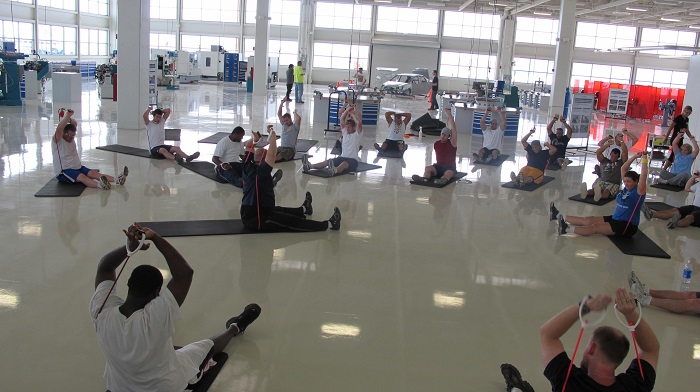Every 23 seconds someone in the U.S is diagnosed with diabetes.
|According to the Centers for Disease Control and Prevention(CDC), more than 29 million Americans are diabetic, and 86 millionmore have prediabetes. Together, these two groups comprise about 45percent of the U.S. workforce.
|The resulting impact on business is significant.
|The Health Care Cost Institute found that, for adults covered byemployer-sponsored insurance, the spending difference betweenpeople with and without diabetes averages more than $10,000 percapita. In addition to direct medical costs, diabetes causes $69billion annually in indirect costs due to reduced productivity.
|With employers bearing much of the cost for chronic disease, many are implementing workplace programs and policies to reducehealth risk factors and lower direct costs, such as insurancepremiums and workers’ compensation claims.
|The CDC’s Workplace Health Program showed that in 2014, 73percent of small companies and 98 percent of large companiesoffered at least one wellness program as part of their healthbenefits. Approaches range from lifestyle change to weightmanagement and health promotion.
|To counter costs from lifestyle diseases like diabetes,employers should aim for a mix of traditional programs,emerging methods and a supportive organizational environment. Theright framework includes five effective, evidence-based ways foremployers to promote workforce wellness and addressdiabetes-related costs:
||
1. Detect risk factors and disease early on
Type 2 diabetes develops slowly over months and years, soscreening initiatives for early detection and treatment areessential.
|A seven-item questionnaire from the CDC can be used as aninitial screen for prediabetes risk, followed by blood glucosescreening for further confirmation.
|While the CDC questionnaire is a simple test to offer to allemployees, the U.S. Preventive Services Task Force recommendsscreening for abnormal blood glucose for the 70 percent of adultsages 40 to 70 who are overweight or obese.
|Employers should utilize workplace health programs that providetools to measure workforce health. Having this information – theactual risk factors among their staff - will help determine theoverall need and type of programs to implement.
||
2. Prevent the progression of health risk
A workplace program that emphasizes modest weight loss, improveddiet, stress management and physical activity can help employersreduce the incidence and impact of type 2 diabetes amongemployees.
|There is strong evidence that the progression from prediabetesto type 2 diabetes can be prevented or delayed.
|Large clinical trials, including the Diabetes Prevention Program(DPP), showed that a structured lifestyle change program can cutthe risk of progression to type 2 diabetes by 60 percent amongadults who were at very high risk.
|The American Diabetes Association and the CDC recommend thatpeople with prediabetes should be counseled on lifestyle changesthrough programs with goals similar to those of the DPP, andresearch indicates that these types of initiatives can be highlycost-effective.
||
3. Help employees take control of their health
Providing employees with evidence-based programs helps themengage more actively in their health, a key step both in preventingtype 2 diabetes and in managing the disease.
|According to the CDC, “effective behavioral interventionscombine counseling on a healthful diet and physical activity andinvolve multiple contacts over extended periods.” Initiatives thatpair guidance with personal goal-setting, weekly action plans andencouragement can support the adoption of healthy behaviors overtime.
|New digital tools are also emerging to extend the delivery andeffectiveness of these programs.
|With the proliferation of smartphones, mobile platforms nowempower people to manage their diet, physical activity and stresswherever they go, enabling employers to support their workforceefficiently and at scale.
||
4. Offer personalized programs adapted to employee needs
Programs to raise awareness, prevent and manage diabetes must beadapted to the needs and preferences of the workforce.
|In particular, workforce efforts must take into accountpotential barriers such as health literacy – the capacity to makeinformed health decisions based on one’s understanding of healthinformation.
|According to the National Assessment of Adult Literacy, nearly90 percent of adults lack proficient health literacy. Low healthliteracy is associated with higher rates of chronic conditions,more frequent preventable hospital visits, and less use ofpreventive services.
|These outcomes are in turn associated with higher health carecosts.
|Programs that equip people of all health literacy levels withthe ability to manage their health are more likely to be successfulin helping employees change behaviors and avoid costlycomplications.
||
5. Support programs through policies, benefits andenvironment
A healthier work environment is a more productive workenvironment.
|Evidence suggests that outcomes are best whenindividually-focused programs are supported by organizational-levelpolicies.
|This means creating a climate that is conducive to wellness:providing flextime for exercise, coverage for preventive servicesand screenings, and on-site resources such as fitness facilities,healthy foods in cafeterias and support from the organization’sleadership.
Complete your profile to continue reading and get FREE access to BenefitsPRO, part of your ALM digital membership.
Your access to unlimited BenefitsPRO content isn’t changing.
Once you are an ALM digital member, you’ll receive:
- Critical BenefitsPRO information including cutting edge post-reform success strategies, access to educational webcasts and videos, resources from industry leaders, and informative Newsletters.
- Exclusive discounts on ALM, BenefitsPRO magazine and BenefitsPRO.com events
- Access to other award-winning ALM websites including ThinkAdvisor.com and Law.com
Already have an account? Sign In
© 2024 ALM Global, LLC, All Rights Reserved. Request academic re-use from www.copyright.com. All other uses, submit a request to [email protected]. For more information visit Asset & Logo Licensing.








